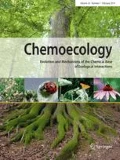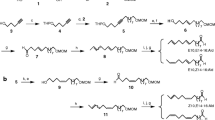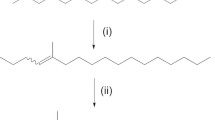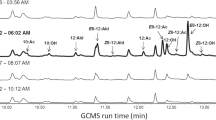Abstract
In a previous study of the sex pheromone of the lesser date moth, Batrachedra amydraula, using laboratory females, (Z4,Z7)-4,7-decadien-1-yl acetate, Z4-decen-1-yl acetate, Z5-decen-1-yl acetate and decyl acetate were identified by sequential SPME-GC/MS analysis. Traces of Z5-decen-1-ol were detected only in airborne collections. Concomitant field tests and re-evaluation of the composition of the sex pheromone of B. amydraula with feral female moths, using an improved sequential SPME-GC/MS procedure revealed a complex mixture of candidate pheromonal compounds. The same unsaturated acetates and the corresponding alcohols: (Z4,Z7)-4,7-decadien-1-ol, Z4-decen-1-ol, Z5-decen-1-ol were positively identified. In addition, the corresponding aldehydes, octanol and octyl acetate were also detected. All compounds were found to be released in a circadian rhythm, in a narrow time window of 2 h, approximately 1 h before sunrise. Comprehensive field bioassays indicated that the optimal attractive blend is a three-component mixture of (Z4,Z7)-4,7-decadien-1-yl acetate, Z5-decen-1-yl acetate and Z5-decen-1-ol in a ratio of 1:2:2. This blend gave about fivefold higher trap catch of B. amydraula males as compared to the previously published binary blend of (Z4,Z7)-4,7-decadien-1-yl acetate and Z5-decen-1-yl acetate in a ratio of 1:2. The alcohol Z5-decen-1-ol is an essential synergistic component of the sex pheromone of B. amydraula. All other identified compounds are inert, being neither synergists nor inhibitors of the pheromone. The optimal pheromone blend will be a useful tool in monitoring and control of B. amydraula, which is a serious pest of date plantations throughout the Middle East and northern Africa.







Similar content being viewed by others
References
Attygalle AB, Jham GN, Svatoš A, Frighetto RTS, Ferrara FA, Vilela EF, Uchôa-Fernandes MA, Meinwald J (1996) (3E,8Z,11Z)-3,8,11-tetradecatrienyl acetate, major sex pheromone component of the tomato pest Scrobipalpuloides absoluta (Lepidoptera: Gelechiidae. Bioorg Med Chem 4:305–314
Blumberg D (1975) Preliminary notes on the phenology and biology of Batrachedra amydraula Meyrick (Lepidoptera: Cosmopterigidae), a new pest of date palms in Israel. Phytoparasitica 3:55–57
Blumberg D (2008) Date palm arthropod pests and their management in Israel. Phytoparasitica 36:411–448
Botes A, Zaid A (2002) The economic importance of date production and international trade. In: Zaid A (ed) Date palm cultivation. FAO, Rome
Byers JA (1992) Optimal fractionation and bioassay plans for isolation of synergistic chemicals: the subtractive-combination method. J Chem Ecol 18:1603–1621
Corey EJ, Suggs JW (1975) Pyridinium chlorochramate an efficient reagent for oxidation of primary and secondary alcohols to carbonyl compounds. Tetrahedron Lett 31:2647–2650
El-Sayed AM (2012) The pherobase: database of insect pheromone and semiochemicals. http://www.pherobase.com
Kakar MK, Nizamani SM, Rustamani MA, Khuhro RD (2010) Periodical lesser date moth infestation on intact and dropped fruits. Sarhad J Agric 26:393–396
Levi-Zada A, Fefer D, Anshelevitch L, Litovsky A, Bengtsson M, Gindin G, Soroker V (2011a) Identification of the sex pheromone of the lesser date moth, Batrachedra amydraula, using sequential SPME auto-sampling. Tetrahedron Lett 52:4550–4553
Levi-Zada A, Fefer D, Anshelevitch L, Litovsky A, Goldenberg I, Rene S, Levski S, Gitgartz L, Carmeli D, Ketner N, Nakash Y, Gindin G, Soroker V (2011b) Identification of the sex pheromone of the lesser date moth, Batrachedra amydraula. Alon Hanotea 65(8):30–34
Levi-Zada A, Nestel D, Fefer D, Nemni-Lavy E, Deloya-Kahane I, David M (2012) Analyzing diurnal and age-related pheromone emission of the olive fruit fly, Bactrocera oleae (Diptera: Tephritidae) by sequential SPME-GCMS analysis. J Chem Ecol 38:1036–1041
Michael IF (1970) Economic importance and control of Batrachedra amydraula Meyr. (the lesser date moth) in the U.A.R. Rep. Date rower’s Inst. 47:9–10
Pawliszyn J (1997) Solid phase microextraction: theory and practice, Wiley-VCH, New York, pp 98–99
Priesner E (1989) Two-component sexual attractant for male Batrachedra pinicolella (Zell.) (Lepidoptera: Batrachedridae). Z Naturforsch 44:1061–1062
Shayesteh N, Marouf A, Amir-Maafi M (2010) Some biological characteristics of the Batrachedra amydraula Meyrick (Lepidoptera: Batrachedridae) on main varieties of dry and semi-dry date palm of Iran. 10th International Working Conference on Stored Product Protection. Julius-Kühn-Archiv 425:151–155
Acknowledgments
The study was supported mainly by the Southern Arava R & D and partially by Hadiklaim, Israel Date Growers Cooperative Ltd. We would like to thank the date growers of Neot-Smadar, Yahel and Yotvata Kibbutzim, in the south Arava, for allowing us to conduct our experiments in their orchards. We thank Mrs Valeriya Seplyarsky of Plant Protection and Inspection Services, Israel Ministry of Agriculture, for her taxonomic examination of the captured moths. Special thanks are due Dr. Ezra Dunkelblum for his valuable advice during the project.
Author information
Authors and Affiliations
Corresponding author
Electronic supplementary material
Below is the link to the electronic supplementary material.
Rights and permissions
About this article
Cite this article
Levi-Zada, A., Sadowsky, A., Dobrinin, S. et al. Reevaluation of the sex pheromone of the lesser date moth, Batrachedra amydraula, using autosampling SPME-GC/MS and field bioassays. Chemoecology 23, 13–20 (2013). https://doi.org/10.1007/s00049-012-0115-9
Received:
Accepted:
Published:
Issue Date:
DOI: https://doi.org/10.1007/s00049-012-0115-9




